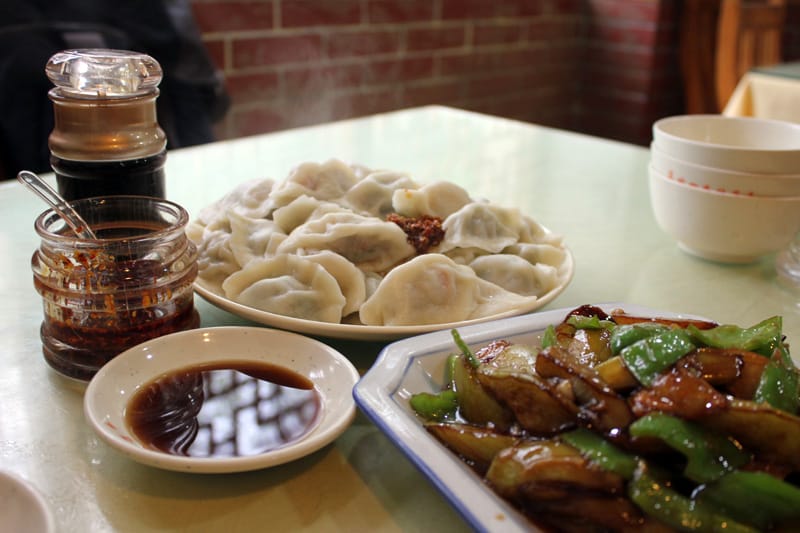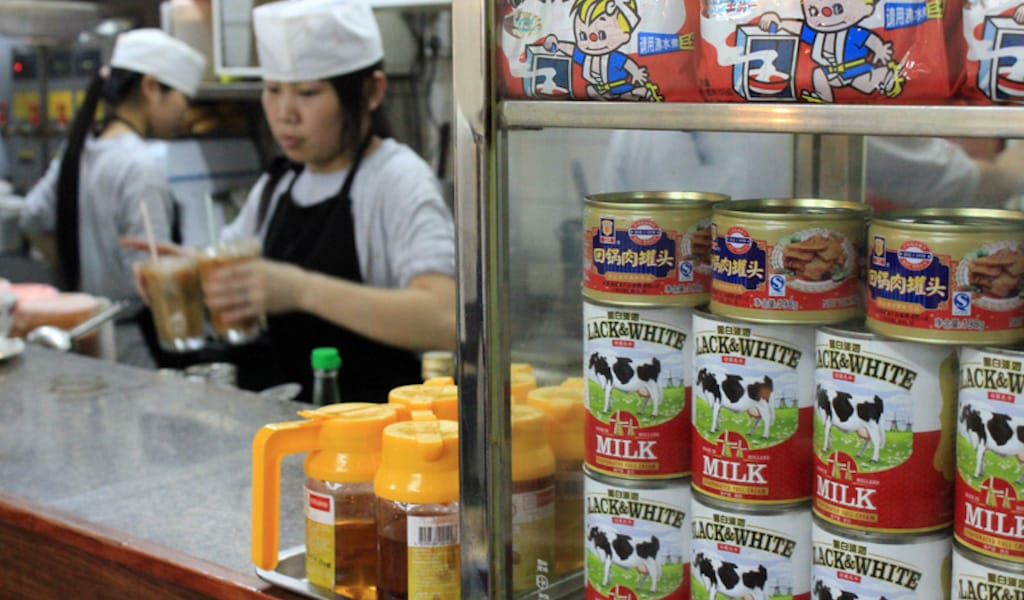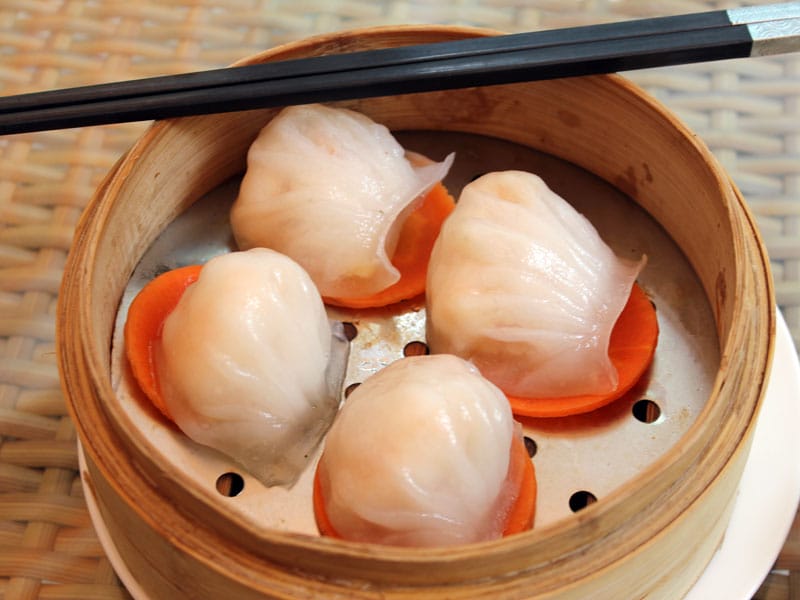With a menu from the frigid provinces that border Korea, Dongbei Siji Jiaozi Wang – literally, “The Four Season Dumpling King from the Northeast” – is all about hearty dishes to warm you up from the inside out.
The further north you head from the Yangtze River, the more the temperate climate demands that wheat trumps rice as the staple grain, often showing up on menus as dumplings and noodles. Yet despite its eponymous claim to represent China’s Northeast, not even the Dumpling King can escape Shanghai’s astringent influence, specifically in the condiment selection. Here you dunk your boiled dumplings in vinegar and sweet chili pepper rather than the typical Northern garnish that adds soy sauce to the mix (or sometimes boldly goes it alone with no vinegar), occasionally coupled with roughly chopped garlic.
Dumplings are ordered by the liang, usually an order of six, and the minimum order is three liang. Everything is thrown together on one plate, making for a culinary treasure hunt of sorts, with diners trying to discern the ingredients in the fillings by taste alone. Pork is the main meat in almost every option, while the most popular vegetable add-ons at The King are green peppers (青椒, qīng jiāo), cilantro (香菜, xiāng cài) and white cabbage (白菜, bái cài).
One can easily make a meal from dumplings alone, but it would be a shame to miss the other signature dishes. The fragrant smashed chicken (香酥鸡, xiāng sū jī) lives up to its name – a whole bird with crispy fried skin is crushed, head and all, onto a plate. Diners test their chopsticks skills, picking around bones, feet and beak to get to the succulent meat.
The other white meat is found battered and fried in “crispy honey pork” (锅包肉,guō bāo ròu). Deep-fried and smothered in a sweet honey-based sauce, it’s lip-smacking good. A dish known as “three earthen treasures” (地三鲜, dì sān xiǎn) shows how versatile eggplant can be, when paired with potato and green pepper and served in a slippery sauce heavy on oil and soy sauce.
The májiàng lāpí (麻酱拉皮) translates unappetizingly as “sesame paste pulled skin,” but is really a plate of delicious mung bean noodles smothered in sesame sauce. The translucent noodles are served refreshingly cold, with julienned cucumber and a sprinkle of cilantro to freshen up the dish. One of the only regional Chinese cuisines to include raw vegetables (the rest of China says salads are for “barbarians”), Northern cuisine shows the culinary influence of the dominating Mongols, who breeched the Great Wall while gnawing on uncooked carrots and cucumbers. (That’s how we imagine it, anyhow.)
For dessert – which will inevitably be served halfway through the meal even if you’ve instructed the waitresses in flawless Mandarin to bring it at the end – order the caramelized bananas or apples (拨丝香蕉/苹果, bō sī píng guǒ/xiāng jiāo). They arrive piping hot at your table, served with plain water in a bowl on the side. Once you pry the sugary fruits away from the dish with your chopsticks, dip them in the water to harden the caramelized sugar shell to a satisfying crunch. Just be careful, as these delicious sweets are very damned-if-you-do, darned-if-you-don’t bites: They store their heat well into the center of the fruit and can burn off taste buds if eaten too quickly. On the other hand, if left to cool too long, the sugar hardens on the plate, and it takes some serious chopstick dexterity to dislodge a single chunk. A dance of culinary precision, this dish is one that is worth the effort.
There are a few branches of Dongbei Siji Jiaozi Wang around town. At the Wuyi Lu location, make sure to check out the medicinal liquors sitting on the cashier’s counter. Deer antlers, turtle shells and mysterious roots soaked in glass canisters of Chinese rice wine make for a fun drinking experiment during dinner.
Editor’s note: We regret to report that the Wuyi Lu location has closed.
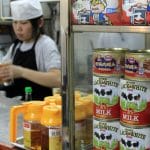 November 9, 2017 Cha’s
November 9, 2017 Cha’s
Hong Kong native and Cha’s owner Charlie Lau became a restaurateur because of a […] Posted in Shanghai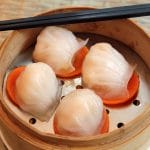 July 1, 2013 Xin Dau Ji
July 1, 2013 Xin Dau Ji
Nothing beats an alfresco summer meal in Shanghai, yet it’s not easy to find a Chinese […] Posted in Shanghai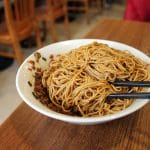 January 28, 2013 Jian Guo 328
January 28, 2013 Jian Guo 328
In Shanghai, there’s a time and a place for taking part in the city’s rough-and-tumble […] Posted in Shanghai
Published on October 10, 2012
Related stories
November 9, 2017
ShanghaiHong Kong native and Cha’s owner Charlie Lau became a restaurateur because of a hankering. A movie producer by day, Lau came to Shanghai with Ang Lee to film Lust/Caution, and was disappointed that Shanghai lacked a proper Hong Kongese cha canting, a casual all-day eatery that serves traditional Cantonese food alongside milk teas and…
July 1, 2013
ShanghaiNothing beats an alfresco summer meal in Shanghai, yet it’s not easy to find a Chinese restaurant that offers outdoor seating. While Chinese people prefer to shelter under umbrellas during the hottest months, Shanghai’s sun-worshipping expats flock to patios and terraces – most of them located in Western-style establishments. So the opening last summer of…
January 28, 2013
ShanghaiIn Shanghai, there’s a time and a place for taking part in the city’s rough-and-tumble street food scene, but sometimes you want to eat out knowing that your bowl of noodles will not accidentally become someone’s ashtray or that you don’t have to elbow an elderly lady out of the way for a seat. Somewhere…







































